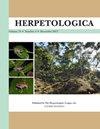一种寒冷气候蜥蜴(Elgaria coerulea)生殖性状的年变异和错过的繁殖机会
IF 1.3
3区 生物学
Q2 ZOOLOGY
引用次数: 0
摘要
摘要:强制冬季不活动通过两种方式影响凉爽气候的工蜂的生活史:(1)产卵和胎生之间的权衡有利于在凉爽气候中胎生的优势;(2) 雌性生殖频率降低。在这项研究中,我们确定了一种胎生蜥蜴(Elgaria coerulea)在凉爽气候种群中繁殖特征的年度变化,以及成年雌性个体的繁殖(与跳过繁殖)模式。我们在加拿大不列颠哥伦比亚省东南部的一项标记再捕获研究中收集了生殖数据。在野外捕获了怀孕的雌性,随后在实验室的半自然条件下分娩,并对由此产生的新生儿进行了测量。不同年份的妊娠雌性在鼻喷口长度(SVL)、相对尾巴长度或年龄上没有差异。只有头部宽度、质量和新生儿状况在不同年份有所不同。大多数窝仔由>80%的活仔组成,并且活仔在窝仔中的比例随着新生儿状况和SVL的增加而增加。产仔数随母体SVL的增加而增加,平均新生儿SVL在中等母体相对尾长时最高。大多数雌性(87%)不每年繁殖,但在繁殖事件之间有一年或几年的间隔。年份对特定雌性是否具有生殖能力没有影响,但体型较大的雌性和尾巴完整的雌性在任何一年都更有可能怀孕。在特定年份跳过繁殖的可能后果包括,用对后代的即时投资来换取当年增长的增长和未来更高的潜在繁殖产出。测试这些假设将具有挑战性,但将大大有助于我们理解繁殖努力的进化,特别是在队友和动物中。本文章由计算机程序翻译,如有差异,请以英文原文为准。
Annual Variation in Reproductive Traits and Skipped Breeding Opportunities in a Cool-Climate Lizard (Elgaria coerulea)
Abstract: Enforced winter inactivity affects life histories of cool-climate squamates in two ways: (1) a trade-off between oviparity and viviparity favoring the predominance of viviparity in cool climates; (2) reduction in frequency of reproduction in females. In this study we determined annual variation in reproductive traits in a cool-climate population of a viviparous lizard (Elgaria coerulea), as well as year-to-year patterns of breeding (versus skipping reproduction) of individual adult females. We collected reproductive data during a mark–recapture study in southeastern British Columbia, Canada. Gravid females were captured in the field and subsequently gave birth under seminatural conditions in the laboratory, whereupon the resulting newborns were measured. There were no differences in snout–vent length (SVL), relative tail length, or age of gravid females among years. Only head width, mass, and condition of newborns varied among years. Most litters consisted of >80% live young, and the proportion of live young in a litter increased with newborn condition and SVL. Litter size increased with maternal SVL, and mean newborn SVL was highest with medium-sized maternal relative tail length. Most females (87%) did not reproduce annually but had one or more years between reproductive events. There was no effect of year on whether a given female was reproductive, but larger females and females with intact tails were more likely to be pregnant in any year. The possible consequences of skipping reproduction in a given year include trading off immediate investment in offspring against increased growth in the current year and higher potential future reproductive output. Testing such hypotheses will be challenging but would contribute significantly to our understanding of the evolution of reproductive effort in both squamates in particular, and animals in general.
求助全文
通过发布文献求助,成功后即可免费获取论文全文。
去求助
来源期刊

Herpetologica
生物-动物学
CiteScore
4.60
自引率
0.00%
发文量
27
审稿时长
>12 weeks
期刊介绍:
Established in 1936, Herpetologica is a quarterly peer-reviewed journal serving herpetologists, biologists, ecologists, conservationists, researchers and the scientific community. The journal contains original research papers and essays about the biology of reptiles and amphibians, and covers many relevant topics including: behavior, conservation, ecology, genetics, morphology, physiology and taxonomy.
 求助内容:
求助内容: 应助结果提醒方式:
应助结果提醒方式:


